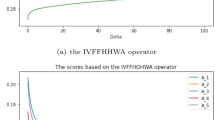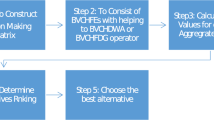Abstract
Complex intuitionistic fuzzy set (CIFS) is a special intuitionistic fuzzy set where the membership and non-membership degrees are expressed by a complex-valued membership degree and can more easily describe the vagueness and uncertainty in the real world. Archimedean t-conorm and t-norm (ATT), as an important class of the t-norm (TN) and t-conorm (TC), have greater flexibility in the information fusion process. In this paper, we extend the ATT to CIFSs and present some generalized geometric aggregation operators, which can be used to handle the multiple criteria decision-making (MCDM) problems. For it, we firstly define some new operational laws of the CIFSs based on ATT, then some weighted geometric aggregation operators based on proposed operations are proposed. Further, some desirable properties and special cases of them are studied. Finally, a decision-making approach is developed for the MCDM problem with complex intuitionistic fuzzy information. A practical example is given to show the availability and advantages of the proposed method by comparison with some existing methods. The proposed aggregation operators are more generalized than the existing ones to utilize the uncertain and imprecise information. Several existing operators are considered as special cases of the proposed one. Finally, the proposed method will offer various choices to the decision-maker to access the finest alternatives.

Similar content being viewed by others
References
Zadeh L A. Fuzzy sets. Inf Control 1965;8:338–353.
Atanassov K T. Intuitionistic fuzzy sets. Fuzzy Set Syst 1986;20:87–96.
Garg H, Kumar K. Linguistic interval-valued atanassov intuitionistic fuzzy sets and their applications to group decision-making problems. IEEE Transactions on Fuzzy Systems 2019;27(12):2301–2311.
Ramot D, Milo R, Fiedman M, Kandel A. Complex fuzzy sets. IEEE Trans Fuzzy Syst 2002;10(2): 171–186.
Alkouri A, Salleh A. 2012. Complex intuitionistic fuzzy sets, vol 1482, Ch. 2nd international conference on fundamental and applied sciences 2012, pp 464–470.
Garg H, Rani D. Complex interval–valued intuitionistic fuzzy sets and their aggregation operators. Fundamenta Informaticae 2019;164(1):61–101.
Tao Z, Han B, Chen H. On intuitionistic fuzzy copula aggregation operators in multiple–attribute decision making. Cogn Comput 2018;10(4):610–624.
Wang J Q, Cao Y X, Zhang H Y. Multi–criteria decision–making method based on distance measure and choquet integral for linguistic Z–numbers. Cogn Comput 2017;9:827–842.
Li X, Chen X. 2018. D–intuitionistic hesitant fuzzy sets and their application in multiple attribute decision making, Cognitive Computation 1– 10. https://doi.org/10.1007/s12559-018-9544-2.
Klir G J, Yuan B. Fuzzy sets and fuzzy logic: theory and applications. New Delhi: Prentice Hall of India Private Limited; 2005.
Garg H, Arora R. Dual hesitant fuzzy soft aggregation operators and their application in decision making. Cogn Comput 2018;10(5):769–789.
Xu Z S. Intuitionistic fuzzy aggregation operators. IEEE Trans Fuzzy Syst 2007;15:1179–1187.
Xu Z S, Yager R R. Some geometric aggregation operators based on intuitionistic fuzzy sets. Int J Gen Syst 2006;35:417–433.
Garg H. Novel intuitionistic fuzzy decision making method based on an improved operation laws and its application. Eng Appl Artif Intel 2017;60:164–174.
Garg H. Generalized intuitionistic fuzzy interactive geometric interaction operators using Einstein t-norm and t-conorm and their application to decision making. Comput Ind Eng 2016;101:53–69.
Yager R R. On ordered weighted avergaing aggregation operators in multi-criteria decision making. IEEE Trans Syst Man Cybern 1988;18(1):183–190.
Garg H. Intuitionistic fuzzy hamacher aggregation operators with entropy weight and their applications to multi-criteria decision-making problems. Iranian Journal of Science and Technology, Transactions of Electrical Engineering 2019;43(3):597–613.
Wang W, Liu X. Intuitionistic fuzzy information aggregation using Einstein operations. IEEE Trans Fuzzy Syst 2012;20(5):923–938.
Wang W, Liu X. The multi–attribute decision making method based on interval–valued intuitionistic fuzzy Einstein hybrid weighted geometric operator. Computers and Mathematics with Applications 2013;66:1845–1856.
Kumar K, Garg H. TOPSIS method based on the connection number of set pair analysis under interval–valued intuitionistic fuzzy set environment. Comput Appl Math 2018;37(2):1319–1329.
Kumar K, Garg H. Connection number of set pair analysis based TOPSIS method on intuitionistic fuzzy sets and their application to decision making. Appl Intell 2018;48(8):2112–2119.
Zhou W, Xu Z. Extreme intuitionistic fuzzy weighted aggregation operators and their applications in optimism and pessimism decision–making processes. J Intell Fuzzy Syst 2017;32:1129–1138.
Arora R, Garg H. Robust aggregation operators for multi–criteria decision making with intuitionistic fuzzy soft set environment. Scientia Iranica E 2018;25(2):931–942.
Arora R, Garg H. Prioritized averaging/geometric aggregation operators under the intuitionistic fuzzy soft set environment. Scientia Iranica 2018;25(1):466–482.
Arora R, Garg H. Group decision – making method based on prioritized linguistic intuitionistic fuzzy aggregation operators and its fundamental properties. Comput Appl Math 2019;38(2):1–36. https://doi.org/10.1007/s40314-019-0764-1.
Kaur G, Garg H. Multi – attribute decision – making based on bonferroni mean operators under cubic intuitionistic fuzzy set environment. Entropy 2018;20(1):65. https://doi.org/10.3390/e20010065.
He Y, Chen H, Zhau L, Liu J, Tao Z. Intuitionistic fuzzy geometric interaction averaging operators and their application to multi-criteria decision making. Inform Sci 2014;259:142–159.
Chen S M, Chang C H. Fuzzy multiattribute decision making based on transformation techniques of intuitionistic fuzzy values and intuitionistic fuzzy geometric averaging operators. Inf Sci 2016;352 - 353:133–149.
Goyal M, Yadav D, Tripathi A. Intuitionistic fuzzy genetic weighted averaging operator and its application for multiple attribute decision making in E-learning. Indian J Sci Technol 2016;9(1):1–15.
Ye J. Intuitionistic fuzzy hybrid arithmetic and geometric aggregation operators for the decision-making of mechanical design schemes. Appl Intell 2017;47:743–751.
Peng X, Dai J, Garg H. Exponential operation and aggregation operator for q–rung orthopair fuzzy set and their decision-making method with a new score function. Int J Intell Syst 2018;33(11):2255–2282.
Peng X D, Garg H. Algorithms for interval–valued fuzzy soft sets in emergency decision making based on WDBA and CODAS with new information measure. Comput Ind Eng 2018;119:439– 452.
Peng X D, Dai J G. Approaches to single–valued neutrosophic MADM based on MABAC, TOPSIS and new similarity measure with score function. Neural Comput Appl 2018;29(10):939– 954.
Ramot D, Friedman M, Langholz G, Kandel A. Complex fuzzy logic. IEEE Trans Fuzzy Syst 2003; 11(4):450–461.
Yager R R, Abbasov A M. Pythagorean membeship grades, complex numbers and decision making. Int J Intell Syst 2013;28:436–452.
Dick S, Yager R R, Yazdanbakhsh O. On pythagorean and complex fuzzy set operations. IEEE Trans Fuzzy Syst 2016;24(5):1009–1021.
Yazdanbakhsh O, Dick S. A systematic review of complex fuzzy sets and logic. Fuzzy Set Syst 2018;338: 1–22.
Alkouri A U M, Salleh A R. Complex Atanassov’s intuitionistic fuzzy relation, Abstract and Applied Analysis 2013 (2013) Article ID 287382, 18 pages.
Kumar T, Bajaj R K. On complex intuitionistic fuzzy soft sets with distance measures and entropies, Journal of Mathematics 2014 (2014) Article ID 972198, 12 pages.
Rani D, Garg H. Distance measures between the complex intuitionistic fuzzy sets and its applications to the decision – making process. Int. J. Uncertain. Quantif. 2017;7(5):423–439.
Garg H, Rani D. A robust correlation coefficient measure of complex intuitionistic fuzzy sets and their applications in decision–making. Appl Intell 2019;49(2):496–512.
Quran A A, Hassan N. The complex neutrosophic soft expert set and its application in decision making. J Intell Fuzzy Syst 2018;34:569–582.
Rani D, Garg H. Complex intuitionistic fuzzy power aggregation operators and their applications in multi–criteria decision-making. Expert Syst 2018;35(6):e12325. https://doi.org/10.1111/exsy.12325.
Garg H, Rani D. Some generalized complex intuitionistic fuzzy aggregation operators and their application to multicriteria decision–making process. Arab J Sci Eng 2019;44(3):2679– 2698.
Wang X, Triantaphyllou E. Ranking irregularities when evaluating alternatives by using some electre methods. Omega – International Journal of Management Science 2008;36:45–63.
Wang W Z, Liu X W. Intuitionistic fuzzy geometric aggregation operators based on Einstein operations. Int J Intell Syst 2011;26:1049–1075.
Garg H. Some series of intuitionistic fuzzy interactive averaging aggregation operators. SpringerPlus 2016;5(1): 999. https://doi.org/10.1186/s40064-016-2591-9.
Huang J Y. Intuitionistic fuzzy Hamacher aggregation operator and their application to multiple attribute decision making. J Intell Fuzzy Syst 2014;27:505–513.
**a M M, Xu Z S, Zhu B. Some issues on intuitionistic fuzzy aggregation operators based on archimedean t-conorm and t–norm. Knowl-Based Syst 2012;31:78–88.
Garg H, Arora R. Distance and similarity measures for dual hesistant fuzzy soft sets and their applications in multi criteria decision-making problem. Int J Uncertain Quantif 2017;7(3):229–248.
Singh S, Garg H. Symmetric triangular interval type–2 intuitionistic fuzzy sets with their applications in multi criteria decision making. Symmetry 2018;10(9):401. https://doi.org/10.3390/sym10090401.
Peng X D, Dai J G. 2018. A bibliometric analysis of neutrosophic set: Two decades review from 1998–2017, Artificial Intelligence Review. https://doi.org/10.1007/s10462-018-9652-0.
Peng X, Selvachandran G. 2017. Pythagorean fuzzy set: state of the art and future directions. Artificial Intelligence Review 1–55. https://doi.org/10.1007/s10462-017-9596-9.
Wei G, Zhang Z. Some single–valued neutrosophic bonferroni power aggregation operators in multiple attribute decision making. J Ambient Intell Humaniz Comput 2019;10(3):863–882.
Wei G W. Pythagorean fuzzy hamacher power aggregation operators in multiple attribute decision making. Fund Inform 2019;166(1):57–85.
Garg H. Nancy, Algorithms for possibility linguistic single-valued neutrosophic decision-making based on COPRAS and aggregation operators with new information measures. Measurement 2019;138:278–290.
Wei G, Wei C, Wang J, Gao H, Wei Y. Some q–rung orthopair fuzzy maclaurin symmetric mean operators and their applications to potential evaluation of emerging technology commercialization. Int J Intell Syst 2019;34(1):50–81.
Wei G, Garg H, Gao H, Wei C. Interval–valued pythagorean fuzzy maclaurin symmetric mean operators in multiple attribute decision making. IEEE Access 2018;6(1):67866–67884.
Author information
Authors and Affiliations
Corresponding author
Ethics declarations
Conflict of Interests
The authors declare that they have no conflict of interest.
Ethical Approval
This article does not contain any studies with human participants or animals performed by any of the authors.
Additional information
Publisher’s Note
Springer Nature remains neutral with regard to jurisdictional claims in published maps and institutional affiliations.
Rights and permissions
About this article
Cite this article
Garg, H., Rani, D. Generalized Geometric Aggregation Operators Based on T-Norm Operations for Complex Intuitionistic Fuzzy Sets and Their Application to Decision-making. Cogn Comput 12, 679–698 (2020). https://doi.org/10.1007/s12559-019-09678-4
Received:
Accepted:
Published:
Issue Date:
DOI: https://doi.org/10.1007/s12559-019-09678-4




